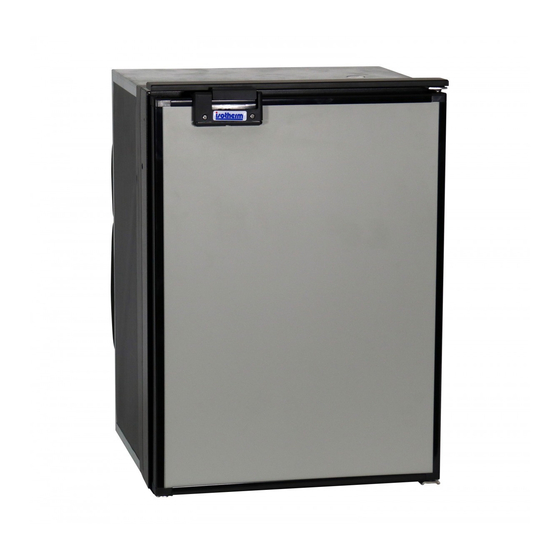Summary of Contents for Isotherm Cruise Line
- Page 1 Cruise Line Marine Refrigerators NSTALLATION AND PERATING NSTRUCTIONS RODUCED BY REAT ATER RUNSWICK AINE GREAT WATER 207 729 8500 TEL 517 813 6509 F INFO GREAT WATER...
-
Page 2: Table Of Contents
Table of Contents Preface Installation Unpacking and Inspection Safety Considerations Tools and Materials Required Getting Good Results Location and Ventilation General Electrical Installation Boat’s Electrical System Changing the Door Panel Re-hanging the Door General Maintenance Defrosting Cleaning Storage Cruise Models with Traditional Thermostats Electrical Connections Operation 7.2.1 Start Up... -
Page 3: Preface
Installation and Service Manual Preface Isotherm Cruise refrigeration systems are designed and built to provide excellent per- formance and many years of trouble-free service. The system is pre-charged with envi- ronmentally safe R-134a refrigerant and can be owner-installed. This manual has been prepared to provide information needed for proper installation, operation and maintenance. -
Page 4: General Electrical Installation
Inlet vent should be located at the bottom (as low as possible) and the outlet vent at the top of the refrigerator (as high as possible); this supports the natural flow of convection of heat from cool (bottom) to warm (top). A vent of 20 to 30 square inches is recommended at top and bottom. -
Page 5: Changing The Door Panel
Changing the Door Panel To suit various boat interiors, the doors of all Cruise refrigerators are available as accesso- ries with panels in white, black, mahogany, teak, and cherry. They may also be covered in other materials of choice. 1. To replace the panel, remove the strip on the lower edge of the door. -
Page 6: General Maintenance
6 General Maintenance Defrosting How often defrosting is needed depends on usage (how often door is opened) and hu- midity. Moist air will produce more frost on the evaporator. It is time to defrost when frost builds up to 1/4 inch. The best way to defrost the refrigerator is to remove all food and place a towel inside the refrigerator, on the bottom of the box. -
Page 7: Cruise Models With Traditional Thermostats
Cruise Models with Traditional Thermostats Electrical Connections 101N0200 Operation 7.2.1 Start Up Make sure the circuit supplying the refrigerator is turned on. The thermostat is adjust- able and has an on/off switch. Turning the control knob to the extreme counter clock- wise position turns the unit off. -
Page 8: Troubleshooting Guide For Cruise Refrigerators
Troubleshooting Guide for Cruise Refrigerators Problem Possible Cause Action Refrigerator isn’t cold. Compressor won't start. Check that power is present at terminal box. Check fuse. Check all connections and cables. Check the thermostat. If the compressor still doesn't start this indicates a fault in the electronic unit or compressor. -
Page 9: Operation
A 30 ft. long accessory cable is available if needed. (Part No. 39230). The ISOTHERM ASU refrigeration system can be operated in two modes. • In the “NORMAL.AUTO” position the ASU program manages the temperature and compressor operation. -
Page 10: Man.temp Position
The ASU processor monitors the supply voltage. When the voltage rises above 13.2 (26.4) volts it will start the compressor and after a short delay gradually increase the speed of the compressor and cooling fan. The indicator LED will shift from yellow to red. -
Page 11: Troubleshooting Guide For Cruise Asu Refrigerators
Troubleshooting Guide for Cruise ASU Refrigerators Problem Possible Cause Action Nothing happens when turned No power supply. Check that main power switch is on. on. All lights off. Check fuse. Green light on. Compressor Holding plate cold enough. No action required. does not start. -
Page 12: Appendix I: How Refrigerators Work
The cooling medium used in Isotherm systems is R134A, an ozone-friendly refrigerant. This is commonly called “freon”. Freon was a brand name applied to an R12 product...


















Need help?
Do you have a question about the Cruise Line and is the answer not in the manual?
Questions and answers